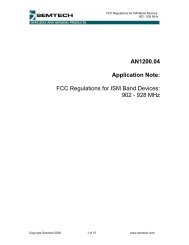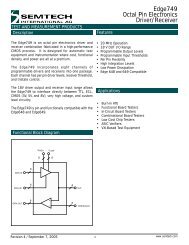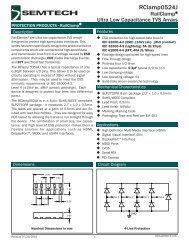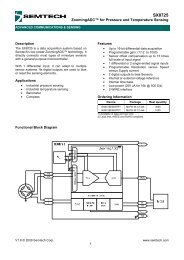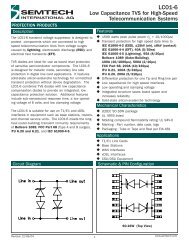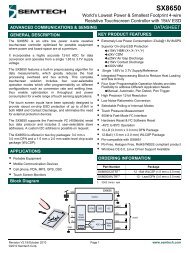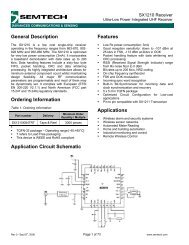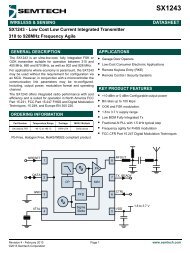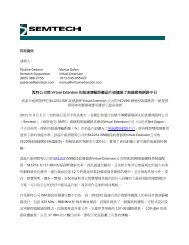"Gigabit Ethernet ESD Protection" application note - Semtech
"Gigabit Ethernet ESD Protection" application note - Semtech
"Gigabit Ethernet ESD Protection" application note - Semtech
Create successful ePaper yourself
Turn your PDF publications into a flip-book with our unique Google optimized e-Paper software.
PROTECTION PRODUCTS<br />
SI01-05<br />
Surging Ideas<br />
TVS Diode Application Note<br />
<strong>Gigabit</strong> <strong>Ethernet</strong> Protection to IEC 61000-4-2,<br />
IEC 61000-4-5, ETSI EN 300 386 and<br />
Bellcore 1089 Intra-Building<br />
As the volume of network traffic increases, the<br />
industry moved quickly from 10Base-T to 100Base-T<br />
(Fast <strong>Ethernet</strong>). Yet the growth of complex computing<br />
<strong>application</strong>s moves the industry to <strong>Gigabit</strong> <strong>Ethernet</strong> for<br />
an even higher speed network technology at the<br />
backbone and server level. Eventually <strong>Gigabit</strong> <strong>Ethernet</strong><br />
will migrate to desktop for general <strong>application</strong>s.<br />
<strong>Gigabit</strong> <strong>Ethernet</strong> has four types of physical layer<br />
signaling: 1000Base-SX (short wavelength optical<br />
fiber), 1000Base-LX (long wavelength fiber),<br />
1000Base-CX (short run copper) and 1000Base-T<br />
(100-meter, four pair category 5 UTP). 1000Base-T is<br />
often the more favored solution for many networks<br />
because of its lower cost-of-entry.<br />
Transient Threats<br />
1000Base-T operates at 125 MHz clock and transmits<br />
and receives (full duplex) on four twisted pairs. It uses<br />
a bi-directional five-level coding scheme that requires a<br />
complex PHY chip. 1000Base-T PHY chips are<br />
routinely manufactured using 0.18-micron technology<br />
with some using 0.13-micron technology. These small<br />
geometries are sensitive to fatal electrostatic<br />
discharges that may originate from a charged cable,<br />
lightning or a “human body”. One of the most common<br />
electrostatic discharges is a Cable Discharge Event<br />
(CDE). A CDE occurs when an <strong>Ethernet</strong> cable becomes<br />
charged (due to its environment) and subsequently<br />
discharges into the circuit when the cable is plugged<br />
into the connector. In general, the waveforms last for<br />
a few hundred nanoseconds with rapid polarity<br />
changes. Another frequent phenomenon is human<br />
“thumbing” of the connectors of the cable resulting in<br />
an immediate <strong>ESD</strong> event. These types of waveforms<br />
last for approximately 60ns and are consistent with the<br />
human body model as defined by immunity standards<br />
such as IEC 61000-4-2. For outside connections,<br />
lightning can also induce high voltage onto the lines<br />
that can be transferred to the <strong>Ethernet</strong> PHY IC. These<br />
events are high energy pulses, lasting several<br />
microseconds. Many systems supporting 1000 Base-T<br />
are required to meet the IEC 61000-4-2 (<strong>ESD</strong>) if it is<br />
an inside line and IEC 61000-4-5 level 2 (lightning) if it<br />
is an outside line. The ETSI EN 300 386 requires the<br />
IEC 610004-5 for both inside and outside lines. Lines<br />
that are connected to the Plain Old Telephone System<br />
Revision 02/15/2002<br />
Figure 1 - SLVU2.8-4 Schematic<br />
CH1 S21 LOG 10 dB/ REF 0 dB<br />
START .030 000 MHz STOP 3 000. 000 000 MHz<br />
Figure 2 - SLVU2.8-4 Insertion Loss<br />
(POTS) line will have to meet the Bellocore 1089<br />
Intrabuilidng specification.<br />
<strong>Ethernet</strong> ports are highly susceptible to line-to-line or<br />
metallic surges. During a metallic surge, current will<br />
flow into one line, through the transformer and back to<br />
the source. As the current flows, it charges the<br />
secondary windings of the transformer. Once the surge<br />
is removed, the secondary winding will stop charging<br />
and will transfer its stored energy to the primary side<br />
where the PHY IC is located. Internal protection<br />
circuitry of <strong>Ethernet</strong> PHY chips is limited at best. It<br />
often consists of small rail-to-rail diodes or thick epi<br />
layers to increase the immunity of the device. Often<br />
1 www.semtech.com
PROTECTION PRODUCTS<br />
PROTECTION PRODUCTS<br />
the internal protection circuit is damaged during the<br />
initial discharge followed by damage to the CMOS<br />
structure after subsequent discharges. Catastrophic<br />
failures are easy to detect and identify. Latent failures<br />
are however very difficult to find and often manifest<br />
themselves as “bugs” and reliability problems.<br />
Meeting IEC 61000-4-5 and ETSI 300 386<br />
Transient protection of a <strong>Gigabit</strong> <strong>Ethernet</strong> interface can<br />
be challenging. The high-speed data transmission<br />
requires the protection device to have low capacitance<br />
to prevent signal degradation and low clamping voltage<br />
to reduce stress on the protected IC. <strong>Semtech</strong>’s<br />
SLVU2.8-4 meets these criteria. The circuit diagram of<br />
SLVU2.8-4 is shown in Figure 1. It is in a SO-8 package<br />
and may be used to protect two high-speed line pairs.<br />
The TVS diode is constructed using a proprietary EPD<br />
process technology yielding a device with superior<br />
electrical characteristics at an operating voltage of<br />
2.8V. The series compensation diode acts to reduce<br />
the loading capacitance to a maximum of
PROTECTION PRODUCTS<br />
SI01-05<br />
Surging Ideas<br />
TVS Diode Application Note<br />
Figure 3 - <strong>Gigabit</strong> <strong>Ethernet</strong> IEC 61000-4-5 and ETSI 300 386 Lightning Protection Circuit<br />
© 2002 <strong>Semtech</strong> Corp. 3<br />
www.semtech.com
PROTECTION PRODUCTS<br />
PROTECTION PRODUCTS<br />
SI01-05<br />
Surging Ideas<br />
TVS Diode Application Note<br />
Figure 4 - <strong>Gigabit</strong> <strong>Ethernet</strong> Bellcore 1089 Intra-Building Protection Circuit<br />
© 2002 <strong>Semtech</strong> Corp. 4<br />
www.semtech.com



